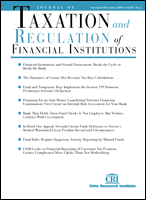Complete Issue
Author: Houman B. Shadab.
Source: Volume 27, Number 06, July/August 2014 , pp.1-52(52)

< previous article |return to table of contents
Abstract:
Our first article deals with tax issues that arise when a company provides funds to a subsidiary using intercompany indebtedness. Galia Antebi and Nina Krauthamer focus on the important tax issue of whether such debt will be deemed disguised equity because it is not negotiated at arm’s length. The authors review case law that is applicable in this area, the analysis of which turns on various factors. Next, Ati P. Khatri and Shinong Wang tackle emerging issues facing providers of guaranties. The authors note that lenders, by increasingly providing guaranties, by the same token may be exposing themselves to challenges by underlying obligors. The authors focus on fraudulent conveyance and lack of consideration challenges in the context of upstream and cross-stream guaranties. Credit ratings agencies were the subject of reform under the Dodd-Frank Act of 2010. In our third article, James J. Farrell, Christoper Harris, and Zachary Rowen discuss legal challenges facing credit ratings agencies in the form of litigat n and expanded liability, and Department of Justice enforcement under the Financial Institutions Reform, Recovery, and Enforcement Act of 1989, as well as various state Attorney’s General cases. Our fourth article details how lenders can protect themselves before their borrowers go into bankruptcy. C. Edward Dobbs addresses intercreditor issues that arise in the context of lien subordination agreements between two lenders. Specifically, Mr. Dobbs looks at a transactional structure using split-collateral loans with a first-lien lender that provides a working capital facility and a second-lien institutional lender that provides a term loan. Our final article provides a summary of the progress and outstanding issues in the civil litigation surrounding the Madoff fraud. Ali Salameh discusses the claims and outcomes of the trustee appointed pursuant to the Securities Investor Protection Corporation. Mr. Salameh finds that financial institutions have largely been insulated from feeder fund liability but that the i ue of how courts may allocate losses among investors in Ponzi scheme remains unsettled.Keywords: intercompany debt; true debt; Bankruptcy Code Sec. 548; “actual malice” defense; rater-ratee relationship; Section 10(b) claims; Section 11 claims; FIRREA; intercreditor disputes; subordination agreement; lien priority; SIPA proceedings
Affiliations:
1: New York Law School.